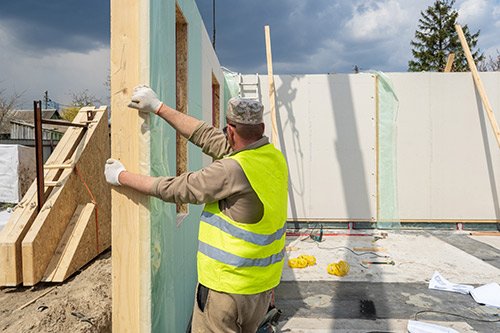What are the Different Types of Materials Used in Making Walls of Modular Homes

Modular homes, known for their versatility, efficiency, and sustainability, rely on various materials to construct their walls. The choice of wall materials plays a crucial role in determining the durability, energy efficiency, aesthetics, and environmental impact of the modular structure. Let’s explore the commonly used materials in modular home walls and their benefits.
1. Structural Insulated Panels (SIPs)
SIPs are prefabricated wall panels made of a rigid foam core sandwiched between two structural facings, usually oriented strand boards (OSB).
Advantages:
- Excellent thermal insulation, reducing energy consumption.
- Lightweight yet structurally strong.
- Quick and easy to assemble, minimizing construction time.
Applications:
Used in walls for energy-efficient modular homes, particularly in regions with extreme climates.
2. Plywood and Fiber Cement Panels
Plywood or fiber cement boards are common materials for modular home walls due to their durability and adaptability.
Advantages:
- Fire and moisture resistance (fiber cement).
- High structural strength (plywood).
- Customizable finishes for both exterior and interior walls.
Applications:
Ideal for modular homes in areas prone to heavy rainfall or humidity, as they offer excellent protection against weather elements.
3. Gypsum Boards
Gypsum boards, also known as drywall, are widely used for interior walls in modular homes. They are lightweight, easy to install, and provide a smooth finish.
Advantages:
- Fire resistance.
- Cost-effective and easy to repair.
- Suitable for painting or wallpapering.
Applications:
Commonly used for interior partitions, providing a clean, finished look to modular homes.
4. Metal Panels
Steel or aluminum panels are often used for modular home walls, particularly in modern designs and industrial-style homes.
Advantages:
- High durability and resistance to corrosion.
- Lightweight and easy to transport.
- Sleek and modern appearance.
Applications:
Frequently used for exterior walls in container homes or modular units with an industrial aesthetic.
5. Concrete Panels
Precast concrete panels offer robust and durable wall solutions for modular homes. These panels are manufactured off-site and assembled on location.
Advantages:
- High structural strength and longevity.
- Resistant to fire, weather, and pests.
- Excellent thermal mass for energy efficiency.
Applications:
Suitable for modular homes in regions requiring enhanced durability, such as urban areas or disaster-prone zones.
6. Wood Panels and Timber Frames
Wood panels or timber frames are commonly used for modular home walls, offering a natural and warm aesthetic.
Advantages:
- Eco-friendly and renewable material.
- Easy to work with, allowing for quick customization.
- Provides excellent insulation.
Applications:
Popular in modular homes designed for rural, forested, or mountainous locations.
7. Composite Materials
Composite materials combine two or more substances, such as recycled plastics and wood fibers, to create durable and versatile wall panels.
Advantages:
- Eco-friendly, using recycled materials.
- Highly durable and resistant to moisture and pests.
- Low maintenance and customizable.
Applications:
Ideal for eco-friendly modular homes and those requiring innovative, sustainable designs.
8. Glass Panels
Glass is used in modular homes for accent walls or to create transparent, light-filled spaces.
Advantages:
- Aesthetic appeal with a modern, open look.
- Allows natural light to enter, improving energy efficiency.
- Heat-treated or double-glazed options for strength and insulation.
Applications:
Typically used for luxury modular homes, sunrooms, or office units to create a modern and elegant appearance.
Choosing the Right Material
The choice of wall material depends on factors like:
- Climate: SIPs or concrete panels are ideal for extreme climates, while wood works best in moderate conditions.
- Aesthetics: Glass and metal panels suit modern styles, while wood provides a rustic charm.
- Cost: Gypsum and plywood are cost-effective, while SIPs and composites may require a higher initial investment.
- Durability: Concrete and metal panels are long-lasting and low maintenance.
The materials used in modular home walls significantly influence the functionality, comfort, and appeal of the structure. Modern construction technologies allow for combining these materials to create homes that are durable, energy-efficient, and visually stunning. Whether you prioritize sustainability, cost, or aesthetics, there’s a modular wall material perfectly suited for your needs.
By understanding these materials and their applications, homeowners and builders can make informed decisions to ensure the success of their modular home projects.
